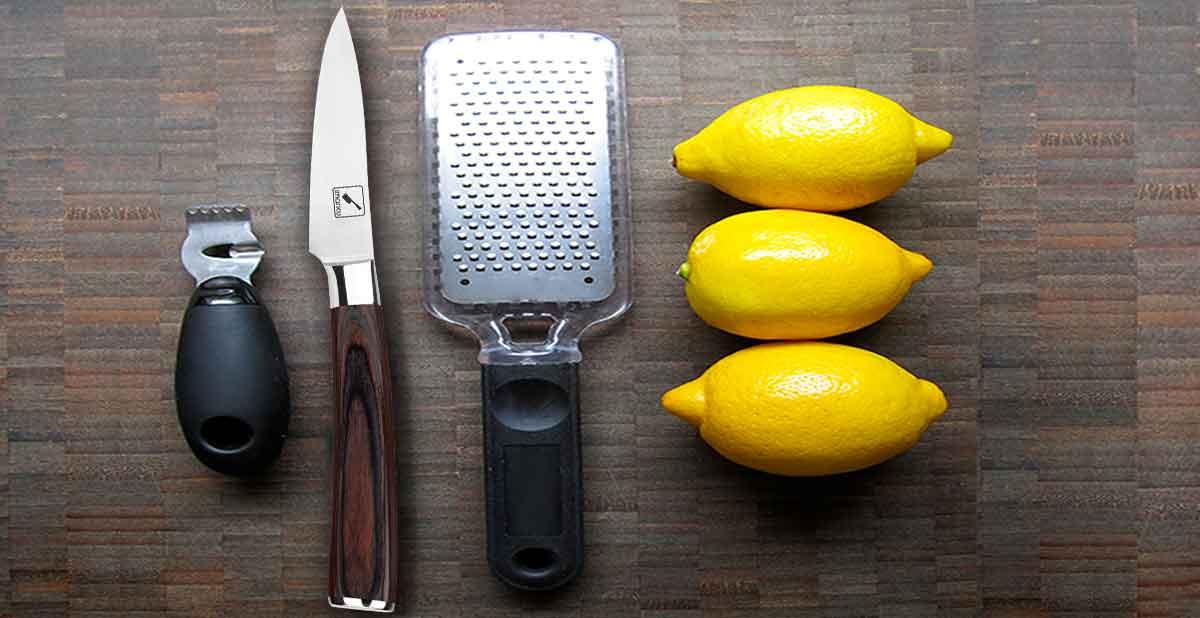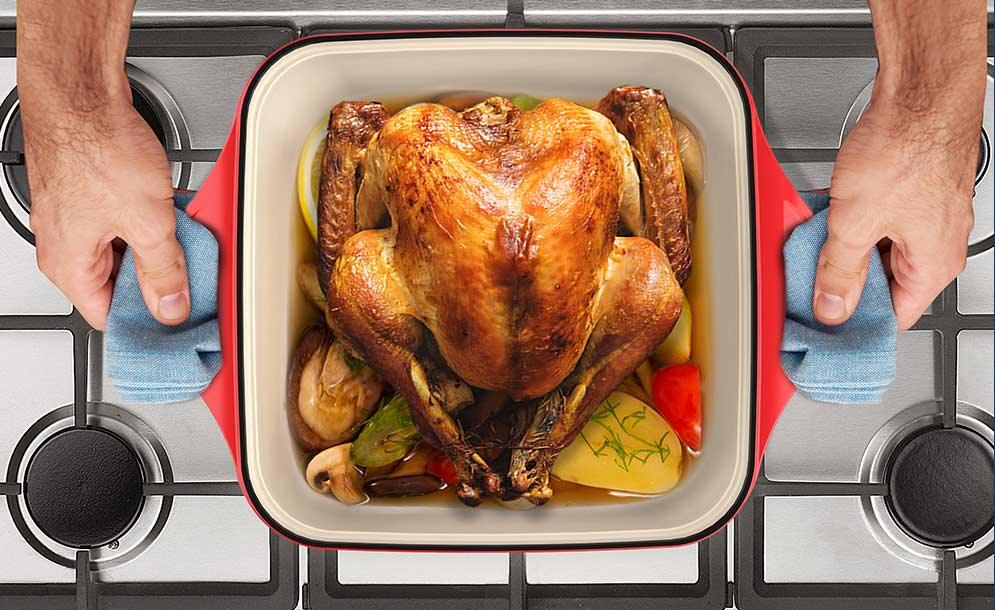TABLE OF CONTENTS
What is Lemon Zest?
Lemons: a staple in kitchens all across the globe, but rarely ever enjoyed the same way one might take a bite out of an apple or eat a section of orange. Lemons certainly pack a strong, powerful flavor, but when used in moderation, that flavor becomes bright and energizing.
Zesting a lemon is a great way to harness some of that citrusy, delicate flavor. Many recipes, from grilling to baking to preserving and more, all call for chefs to zest a lemon. But how exactly do you get lemon zest, anyway? And how do you avoid the bitter white peel lurking underneath, sure to add an unpleasant profile to your dish?
Fortunately, with the right tools, obtaining lemon zest (or any fruit zest) is easy and almost effortless. Let's walk through some good ways to use lemon zest in your recipes, and three easy ways to make it. Plus, we'll cover the best tools to use and some pro tips from top chefs that you won't find anywhere else (including one thing you should never, ever do)!
How to Zest A Lemon in 3 Easy Ways
There's no one right way to zest a lemon, but there are certainly quite a few wrong ways! Let's cover three ways to make lemon zest at home without any hassle.
1. Use a Grater
The easiest and most common method to zest a lemon is to use a grater. Any kind of grater will work, such as a cheese grater, but most prefer to use one that produces finer zest. Depending on what you'll be using your zest for, you might opt for larger shavings. This creates a weaker flavor, as fewer natural oils are released in the grating process.
However, large grains can add a unique texture or pop of color to marinades or finished baked goods. Finer grains of lemon zest will feel slightly damp, as so much of their natural oils have been released in the process. In fact, in some cases, you may want to pat the zest dry before adding it into a mixture. The excess moisture can cause the grains to sink in baked goods or add to your cooking time.
When gratering, gently buff over the surface of the lemon. Some recipes call for teaspoons or grams of zest, but most call for the zest of half a small lemon, whole lemon, and so on. You won't have to worry about adding too much zest, because the flavor is far milder than the juice itself.
Turn the lemon over and continue buffing for more zest. Here's the most important tip you'll hear from any top chef: don't throw that lemon away! Even without its yellow layer, lemons are still good to be kept around until use. Next time you order water with lemon at a restaurant, see if your lemon slice has a peel. If not, chances are the chefs used the lemon for its zest before repurposing it for drinks!
2. Thinly slice the peel
What if you want a longer, intact slice of zest? This is more common than you think, especially for pastries and garnishes. In fact, zest prepared this way is also often used in the preparation of candles and other DIY goods!
In order to prepare zest by slicing, you'll first need a high quality, sharp knife. You might consider grating a small area first to get an idea of how deep the peel is. Grasping the lemon firmly on a counter, tucking your fingers and slicing away from you, gently saw off the external layer. If you get some white on your zest, it's fine. A little white won't overwhelm the flavor, but a large portion of it will.
3. Use a vegetable peeler
If you just can't seem to thinly slice the peel without butchering the lemon, chances are that you have a dull knife! Another good option to use in a pinch is to use a vegetable peeler. Vegetable peelers allow for a surprising range of sensitivity.
They can create stylish, spiral shavings that go great in mixed drinks or as a garnish. Using a spiralizing peeler, you can get one long, thin strip of peel, sans the white part. This is great if you plan on candying the peel but feel nervous about simmering away the bitterness of the white.

Uses of Lemon Zest
Can the gratings from a lemon peel really make a difference in your food? The answer is yes! We've all likely tried eating a lemon wedge in our lifetime. There are tons of unpleasant flavors, including the sharp, sourness of the fruit and the overwhelmingly bitter taste of the peel. But what you may not have noticed is that the outside of the lemon contains a light, refreshing hint of citrus.
A Hidden Gem
Only a small layer on the outside of the lemon is yellow; this layer contains the flavonoids you'll want for your recipe. Directly beneath that layer is the bitter white peel you'll want to avoid at all costs, unless you plan on reducing the peels or candying them to make them edible.
For that reason, the best way of zesting a lemon involves gently grating or scraping the surface to extract just the top layer of the lemon. As soon as you see white appear underneath the grating area, it's time to stop!
Small But Mighty
Lemon zest has a variety of uses, but the most popular use is to add a touch of lemon flavor without accidentally overpowering the recipe. Lemon juice is notorious for this, as it is very potent. Lemon juice also contains citric acid, and between the addition of more liquid and the acidity, a small amount of juice can throw off the entire recipe.
Lemon zest is a safe addition when you want a little brightening, citrusy flavor. The flavor it adds isn't too sharp or pungent. It's more floral in nature, and blends in well with a variety of flavors.
An Unlikely Duo
That's why lemon zest is so popular in the preparation of seafood dishes. On its own, lemon juice can easily mask the flavors of meats such as lobster, crab, or scallops. These meats are quite expensive, and it would be a shame to taste nothing but lemon! Zest adds a touch of brightness that compliments well with the buttery undertones of seafood. It doesn't overwhelm the flavor profile, making it a common inclusion in drawn butter.
Recommended Tools To Zest a Lemon
A high-quality, well forged, sharpened knife can completely upgrade your kitchen experience. Extracting zest from fruit by thinly slicing it is fast, easy, and fun. It's by far the cleanest method and extracts the most zest from the lemon compared to the other ways. Slicing a lemon is effortless with the right tool. The iMarku 3.5" Paring Knife is a fan favorite for its easy handling and precision. It's made with genuine German stainless steel and features an ergonomic handle for maximum control.
Another must-have to zest a lemon? The Vestaware 4.5" Paring Knife. This blade is a great multipurpose tool for peeling, chopping, slicing, and so much more. Use the ultra-thin blade to slice through lemon zest easily, then use the refined point to quickly devein shrimp and fillet seafood. It'll quickly become the go-to knife in your connection, and since Vestaware and iMarku are partners, you can be sure that the quality is unmatched.
Pro Tips For Zesting A Lemon
It's best to start off on the right foot by selecting a sharpened, high-quality tool. Remember that graters become dull over time, especially since their edges aren't as precise as a knife blade. When making zest, try to use it the same day. The aroma and flavor will be strongest just after grating.
Lemon Zest Substitutes
Don't have a lemon on hand? There's nothing to worry about. If you have a bottle of lemon juice lying around, a light splash will work as a replacement. Don't measure the juice the same as the zest. Rather, aim to use around half the amount that the recipe calls for.
How Much Zest Does a Lemon Make?
You can expect an average-sized lemon to produce one tablespoon of zest, but other fruits may produce more or less. Do you have an orange, lime, or even a mandarin at home? You can zest those, too! The flavor profile will be slightly different, but no one will be the wiser in most cases.
The point of zest is to add acidity and freshness to dishes, and other citruses will work just as fine. Some fruits, like lime, may not have as much sweetness as a lemon. You might consider adding a little sugar or mixing in some orange zest.
How Do You Store Lemon Zest?
The best way to store lemon zest is to keep it on the lemon! Fresh zest is best, so try not to grate too much zest at once. You can zest from the same lemon for as long as it would keep normally. However, if you do have extra zest, you can store it in an airtight container.
Some people freeze their zest into small ice cubes, which are great to pop into a cup of tea. You can also put a paper towel in with your zest to absorb excess moisture. As the zest ages, the oils will continue to break down and create liquid. A paper towel can help blot any unwanted oils.

Infusing Bright and Bold Flavors to Your Meals
Lemon zest is one of the few herbs and spices that can be used in sweet and savory dishes alike. The flavor is milder than the juice of the actual lemon, so it's much easier to work with. Once you get the hang of it, you'll be experimenting with adding zest to all your dishes! Happy cooking!






















Leave a comment
All comments are moderated before being published.
This site is protected by hCaptcha and the hCaptcha Privacy Policy and Terms of Service apply.